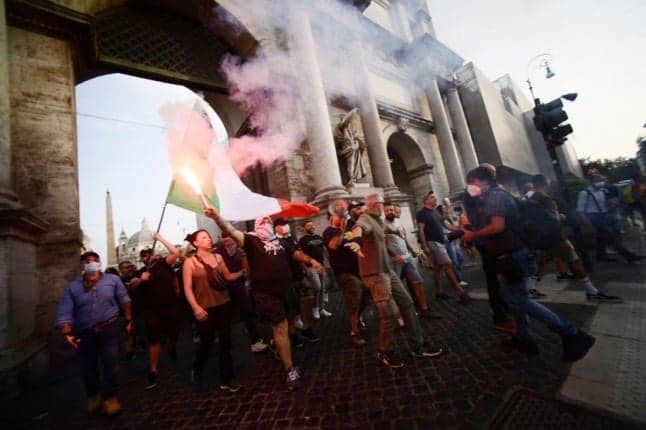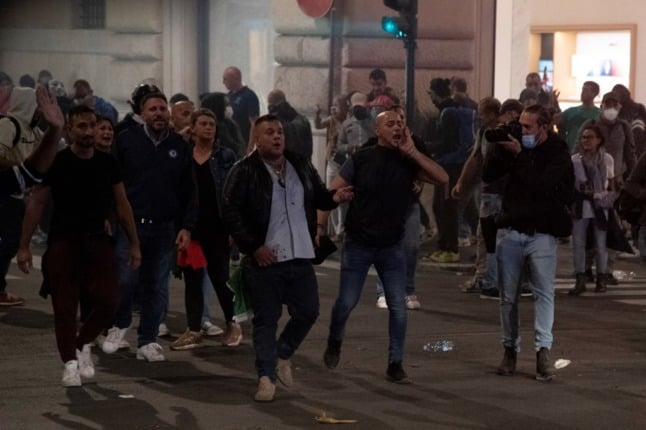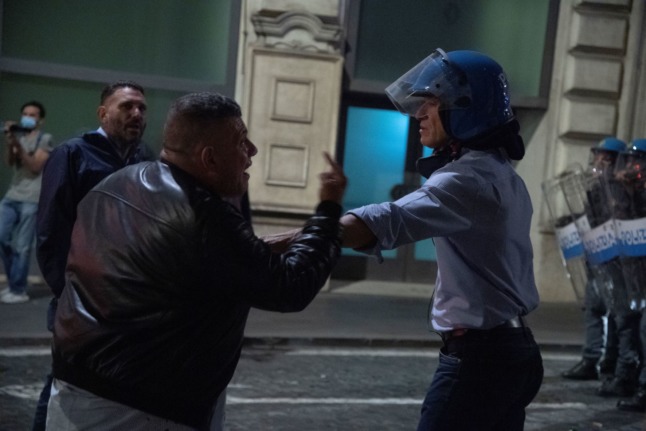Analysis: What’s behind Italy’s anti-vax protests and neo-fascist violence?

There are growing calls in Italy for new laws against groups aligned with fascism after violent clashes with police followed a protest against Italy's green pass in Rome. How did all this start, and what comes next?
On Saturday, an estimated ten thousand protestors demonstrated in Rome’s Piazza del Popolo against an incoming expansion of the green pass health certificate requirement imposed by the Italian government. By Saturday night, clashes with police had left 38 officers injured and buildings ransacked.
Members of Forza Nuova who took part in the demonstrations broke into and occupied the headquarters of the CGIL labour union federation, smashing up the premises.
Several hundred others, also believed to have been led by Forza Nuova, targeted the prime minister's office but were pushed back by police using tear gas and water cannon.
12 Forza Nuova members were subsequently arrested, and there are now growing calls for the party - and other similar groups - to be disbanded.
But what does this neo-fascist group have to do with a protest about a mandatory health certificate?
What was the protest about?
From October 15th, all workers across the public and private sectors in Italy will be required to produce a Covid-19 health certificate or ‘green pass’ to be able to enter the workplace.
The requirement had already been in place since September 1st for schoolteachers and university staff, as well as for anyone wanting to use long-distance public transport; and the certificate has been required since August 6th to enter most cultural, entertainment and leisure venues in the country.
The green pass proves bearers have either been vaccinated with at least one dose, have recovered from Covid-19 within the past six months, or have tested negative in the previous 48 hours (for rapid antigen tests) or 72 hours (for molecular PCR tests).
This means that workers can opt for testing instead if they refuse the vaccine. But coronavirus tests have never been free in Italy, and those who wish to remain unvaccinated must pay for one every two to three days.
Some of those demonstrating complained about the cost of testing and accused the government of using coercive tactics, while others held signs or wore t-shirts with slogans referring to conspiracy theories about vaccines.
With 8.4 million people who are eligible for a Covid shot in Italy still unvaccinated, and just days to go until the new rules kick in, it’s likely these most committed holdouts who made up the bulk of the crowd demonstrating over the weekend.
READ ALSO: EXPLAINED: Where do you now need to show a Covid green pass in Italy?

Anti-green pass protesters demonstrate in Rome before the event descends into violence on October 9, 2021. Photo: Tiziana FABI/AFP
An estimated 10,000 people attended the protest, according to the news daily Corriere della Sera, making it the largest protest Italy has seen over coronavirus restrictions.
Previous demonstrations around the country - including one led by Forza Nuova in Rome July - attracted just a few hundred protestors.
One of the largest, held at the Piazza del Popolo in June, drew 1,000 demonstrators.
Who are Forza Nuova and why are they involved in the protests?
Forza Nuova was created in 1997 in the tradition of the violent, extreme right-wing organisations active in Italy's so-called Years of Lead in the 1970s, and grew into a national force in 2008.
It demands an abortion ban, a total end to immigration, and the repeal of hate speech laws.
The group is openly neo-fascist. Its current leader, Roberto Fiore, a 62-year-old father to 11 children, was found guilty in the 1980s of subversive crime and founding a far-right armed political movement.
As a political party, it has never achieved a score of even 0.5 percent at any election, even when allied with other far-right groups.
Along with CasaPound, FN is the main neo-fascist organisation active in Italy and often makes headlines for violence against immigrants and police.
Most recently, the group has been involved in several protests against the expansion of Italy’s green pass system, with experts saying the pandemic has opened up new opportunities for the group to find support.
Political expert Marco Revelli, who has written books on Italy's far-right and far-left, said the FN attracts support by helping those on society's margins who feel abandoned by the state, delivering food parcels to the
poorest in city suburbs.
While "certainly not a credible political force", polling at less than one percent of the vote, he said it has been infiltrating anti-lockdown and anti-vaccine demonstrations.
"The pandemic has opened up new ground," the retired professor of political science told AFP.

Protesters shout abuse during clashes with police in Rome on Saturday night. Photo: Tiziana FABI/AFP
It’s unclear how many of Saturday’s protesters were aligned with the party, but the demonstrators were reportedly bussed in from all over the country, with at least 56 minivans, five coaches, and numerous other motor vehicles identified by police currently reviewing security footage.
In a raid last month, police reportedly found batons, smoke bombs, and ‘No Pass’ banners in the home of Forza Nuova Rome leader Giuliano Castellino and other figures high up in the party.
"Tonight we'll take Rome," Castellino is reported to have shouted during a speech to the crowd, before leading a charge on Palazzo Chigi, the seat of the Council of Ministers and the official residence of the Italian prime minister.
While police prevented rioters from reaching Palazzo Chigi using water cannon and tear gas, video footage appeared to show a small number of officers overwhelmed by a violent mob outside the CGIL building.
CGIL, the Italian General Confederation of Labour, was formed by agreement between the anti-fascist socialists, communists, and Christian democrats in the "Pact of Rome" of June 1944, and is an obvious targe for those with extreme right-wing views.
Once inside, rioters were reported to have used a loudspeaker to make accusations that CGIL had "betrayed" workers by allowing the green pass expansion to go ahead.
Castellino is now under house arrest with an electronic tag and a five-year DASPO (a ban on attending sporting events, usually used against football hooligans).
“For me this is a medal, I’ll continue the fight,” he’s reported to have said.
Among the other other Forza Nuova leaders arrested are the group's national head Roberto Fiore and the restauranteur Biagio Passaro, leader of the IoApro ("I open") movement against coronavirus lockdowns, reports the national broadcaster Rai.

Forza Nuova Rome leader Giuliano Castellino gestures at a riot police officer during clashes in central Rome on Saturday. Photo: Tiziana FABI / AFP
What happens next?
Politicians across the spectrum condemned the violence, and the centre-left Democratic Party (PD) and the once anti-establishment Five Star Movement (M5S) on Monday signed a motion in parliament calling for Forza Nuova to be banned.
PD leader Enrico Letta, a former prime minister, compared Saturday's events to the storming of the US Capitol in Washington by supporters of Donald Trump.
"Neofascist groups have tried to use this difficult (pandemic) situation for acts of insurrection, nothing more and nothing less than what happened in the United States on January 6th," he said.
Two separate investigations into the riots in the capital have already been opened by prosecutors, Italian media reported.
FN's website was taken offline Monday by order of a Rome court as part of an investigation into alleged "incitement to violence".
READ ALSO: Riots put Italian government under pressure to ban neo-fascist groups
Palazzo Chigi has issued a statement saying that rules on protests must be tightened in the wake of Saturday’s clashes.
The institution has said that demonstrations should only be permitted after a rigorous risk assessment, "to demonstrate that the State exists and intervenes to counter the violent, to crush extremism and the initiatives of those who aim to create tension and instability," reports Corriere della Sera.
Comments
See Also
On Saturday, an estimated ten thousand protestors demonstrated in Rome’s Piazza del Popolo against an incoming expansion of the green pass health certificate requirement imposed by the Italian government. By Saturday night, clashes with police had left 38 officers injured and buildings ransacked.
Members of Forza Nuova who took part in the demonstrations broke into and occupied the headquarters of the CGIL labour union federation, smashing up the premises.
Several hundred others, also believed to have been led by Forza Nuova, targeted the prime minister's office but were pushed back by police using tear gas and water cannon.
12 Forza Nuova members were subsequently arrested, and there are now growing calls for the party - and other similar groups - to be disbanded.
But what does this neo-fascist group have to do with a protest about a mandatory health certificate?
What was the protest about?
From October 15th, all workers across the public and private sectors in Italy will be required to produce a Covid-19 health certificate or ‘green pass’ to be able to enter the workplace.
The requirement had already been in place since September 1st for schoolteachers and university staff, as well as for anyone wanting to use long-distance public transport; and the certificate has been required since August 6th to enter most cultural, entertainment and leisure venues in the country.
The green pass proves bearers have either been vaccinated with at least one dose, have recovered from Covid-19 within the past six months, or have tested negative in the previous 48 hours (for rapid antigen tests) or 72 hours (for molecular PCR tests).
This means that workers can opt for testing instead if they refuse the vaccine. But coronavirus tests have never been free in Italy, and those who wish to remain unvaccinated must pay for one every two to three days.
Some of those demonstrating complained about the cost of testing and accused the government of using coercive tactics, while others held signs or wore t-shirts with slogans referring to conspiracy theories about vaccines.
With 8.4 million people who are eligible for a Covid shot in Italy still unvaccinated, and just days to go until the new rules kick in, it’s likely these most committed holdouts who made up the bulk of the crowd demonstrating over the weekend.
READ ALSO: EXPLAINED: Where do you now need to show a Covid green pass in Italy?

An estimated 10,000 people attended the protest, according to the news daily Corriere della Sera, making it the largest protest Italy has seen over coronavirus restrictions.
Previous demonstrations around the country - including one led by Forza Nuova in Rome July - attracted just a few hundred protestors.
One of the largest, held at the Piazza del Popolo in June, drew 1,000 demonstrators.
Who are Forza Nuova and why are they involved in the protests?
Forza Nuova was created in 1997 in the tradition of the violent, extreme right-wing organisations active in Italy's so-called Years of Lead in the 1970s, and grew into a national force in 2008.
It demands an abortion ban, a total end to immigration, and the repeal of hate speech laws.
The group is openly neo-fascist. Its current leader, Roberto Fiore, a 62-year-old father to 11 children, was found guilty in the 1980s of subversive crime and founding a far-right armed political movement.
As a political party, it has never achieved a score of even 0.5 percent at any election, even when allied with other far-right groups.
Along with CasaPound, FN is the main neo-fascist organisation active in Italy and often makes headlines for violence against immigrants and police.
Most recently, the group has been involved in several protests against the expansion of Italy’s green pass system, with experts saying the pandemic has opened up new opportunities for the group to find support.
Political expert Marco Revelli, who has written books on Italy's far-right and far-left, said the FN attracts support by helping those on society's margins who feel abandoned by the state, delivering food parcels to the
poorest in city suburbs.
While "certainly not a credible political force", polling at less than one percent of the vote, he said it has been infiltrating anti-lockdown and anti-vaccine demonstrations.
"The pandemic has opened up new ground," the retired professor of political science told AFP.

It’s unclear how many of Saturday’s protesters were aligned with the party, but the demonstrators were reportedly bussed in from all over the country, with at least 56 minivans, five coaches, and numerous other motor vehicles identified by police currently reviewing security footage.
In a raid last month, police reportedly found batons, smoke bombs, and ‘No Pass’ banners in the home of Forza Nuova Rome leader Giuliano Castellino and other figures high up in the party.
"Tonight we'll take Rome," Castellino is reported to have shouted during a speech to the crowd, before leading a charge on Palazzo Chigi, the seat of the Council of Ministers and the official residence of the Italian prime minister.
While police prevented rioters from reaching Palazzo Chigi using water cannon and tear gas, video footage appeared to show a small number of officers overwhelmed by a violent mob outside the CGIL building.
CGIL, the Italian General Confederation of Labour, was formed by agreement between the anti-fascist socialists, communists, and Christian democrats in the "Pact of Rome" of June 1944, and is an obvious targe for those with extreme right-wing views.
Once inside, rioters were reported to have used a loudspeaker to make accusations that CGIL had "betrayed" workers by allowing the green pass expansion to go ahead.
Castellino is now under house arrest with an electronic tag and a five-year DASPO (a ban on attending sporting events, usually used against football hooligans).
“For me this is a medal, I’ll continue the fight,” he’s reported to have said.
Among the other other Forza Nuova leaders arrested are the group's national head Roberto Fiore and the restauranteur Biagio Passaro, leader of the IoApro ("I open") movement against coronavirus lockdowns, reports the national broadcaster Rai.

What happens next?
Politicians across the spectrum condemned the violence, and the centre-left Democratic Party (PD) and the once anti-establishment Five Star Movement (M5S) on Monday signed a motion in parliament calling for Forza Nuova to be banned.
PD leader Enrico Letta, a former prime minister, compared Saturday's events to the storming of the US Capitol in Washington by supporters of Donald Trump.
"Neofascist groups have tried to use this difficult (pandemic) situation for acts of insurrection, nothing more and nothing less than what happened in the United States on January 6th," he said.
Two separate investigations into the riots in the capital have already been opened by prosecutors, Italian media reported.
FN's website was taken offline Monday by order of a Rome court as part of an investigation into alleged "incitement to violence".
READ ALSO: Riots put Italian government under pressure to ban neo-fascist groups
Palazzo Chigi has issued a statement saying that rules on protests must be tightened in the wake of Saturday’s clashes.
The institution has said that demonstrations should only be permitted after a rigorous risk assessment, "to demonstrate that the State exists and intervenes to counter the violent, to crush extremism and the initiatives of those who aim to create tension and instability," reports Corriere della Sera.
Join the conversation in our comments section below. Share your own views and experience and if you have a question or suggestion for our journalists then email us at [email protected].
Please keep comments civil, constructive and on topic – and make sure to read our terms of use before getting involved.
Please log in here to leave a comment.